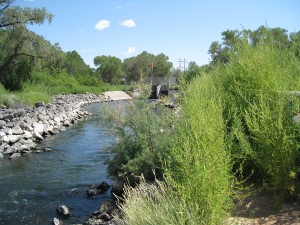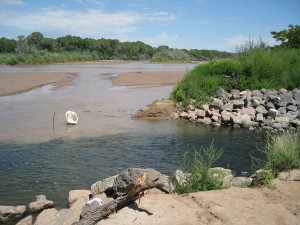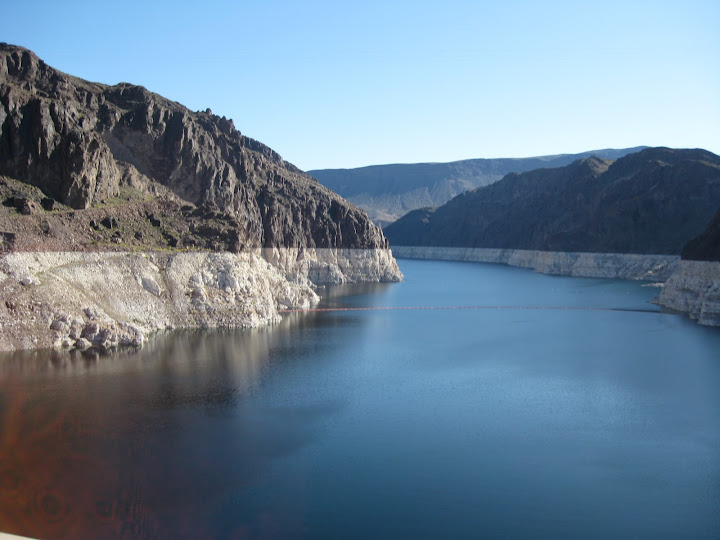It’s been called the largest tributary in New Mexico’s middle Rio Grande – the outfall from Albuquerque’s sewage treatment plant.
A friend loaned me his mountain bike for the weekend (I’m in the market for a new bike that I can ride off the pavement), so I took it for a test ride down in Albuquerque’s south valley, where the sewage treatment plant discharges our cleaned up water into the Rio Grande.

Albuquerque sewage treatment plant outfall, August 2010
I’ve never run the numbers, so I can’t say this with publication-quality authority, but it’s frequently said that it discharges more water annually into the Rio Grande than any natural stream between Otowi and Elephant Butte Reservoir – the stretch we call the “middle Rio Grande.” In round numbers, Albuquerque withdraws about 100,000 acre feet of water per year, consuming about half of it and discharging the rest into the Rio Grande here. Given that the major drainages between Otowi and the Butte are largely ephemeral, flowing primarily during flash floods, I’ve got no reason to doubt the “biggest tributary in the middle Rio Grande” thing.
The water has a bit of a musty smell, and comes out crystal clear, poking out into the Rio Grande before it quickly mixes in with the river’s muddy main stem.

Albuquerque sewage outfall mixes with the Rio Grande, August 2010
By my back-of-the-envelop calculation, the treatment plant’s contribution this time of year is upwards of 10 percent of the river’s flow downstream from this point.
This has been on my mind because I’ve been following George Janczyn’s discussion of San Diego’s Indirect Potable Reuse project. It’s a test of cleaning up some of San Diego’s sewage and returning it to the water system. In arid lands, this seems to me like a no-brainer. Clean the water up and find a way to put it back into the system so it can be used again. In our case, the water is used by irrigators downstream of Albuquerque, ultimately ending up in Elephant Butte Reservoir and on to water users to the south.
Until recently, Albuquerque’s water came from pumped groundwater. In the long run, that has the effect of depleting the river, gallon for gallon, as water leaks out of the riparian system to fill the holes being created by our pumps’ great sucking. But in the shorter term, it has had the effect of a sort of water subsidy for the Rio Grande.
Here, the return flow issue makes for some complicated water policy discussions because of a common misunderstanding of what our net water supply really is. For every 100 gallons we withdraw from the system (from groundwater or the river), we’re putting 50 gallons back into the system where others can use it, so our net consumptive use is just 50 gallons. There are two types of efficiencies we can implement. One type would involve, for example, reducing outdoor watering. A gallon of outdoor watering is entirely consumptive, so saving that gallon by tearing up a piece of lawn saves a gallon of net consumptive use. That gallon never had a chance to get back to the river.
Saving a gallon by installing a low-water toilet is different. If it uses a gallon less per flush, that means one less gallon withdrawn from the system in the first place, as well as one less gallon returned to the river. The effect on our net consumptive use is effectively zero. There are good reasons to do the low-flow toilet anyway – energy consumption in pumping and treating the water, line losses, etc. But things like low-flow toilets and other indoor water efficiencies don’t save as much water, in terms of our overall water budget, as people often think.
If, on the other hand, you’re discharging the effluent from your sewage treatment plant into the ocean, as I understand San Diego does it (So I have this right, George?), then both indoor conservation and things like IPR are, as I said, no-brainers.
In addition to the water math, there were some positive externalities today as a result of our sewage plant return flow, in the form of a trio of lesser yellowlegs poking around in the mud.







